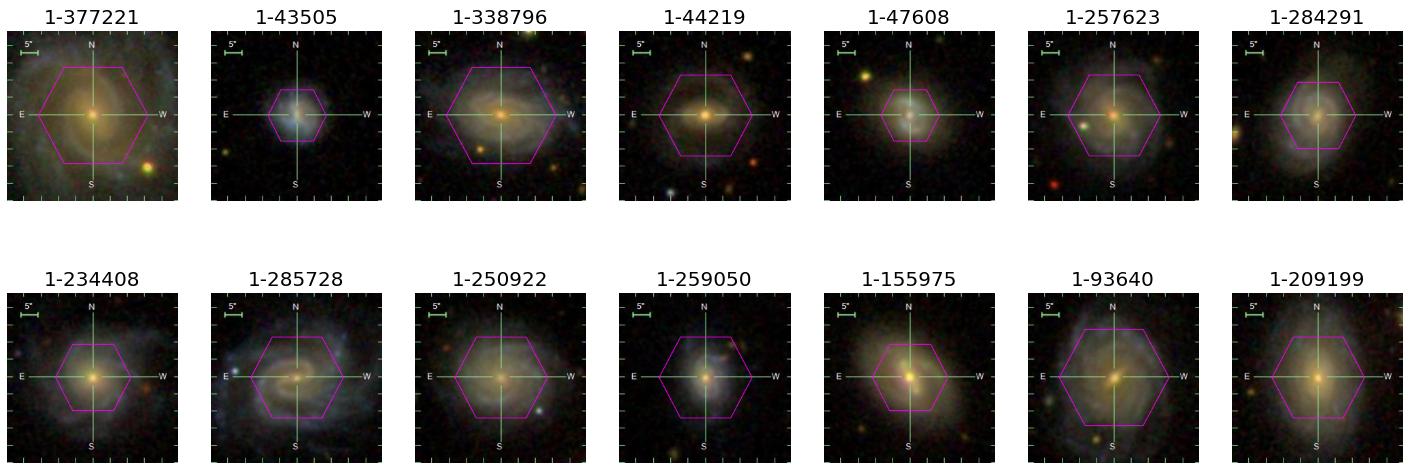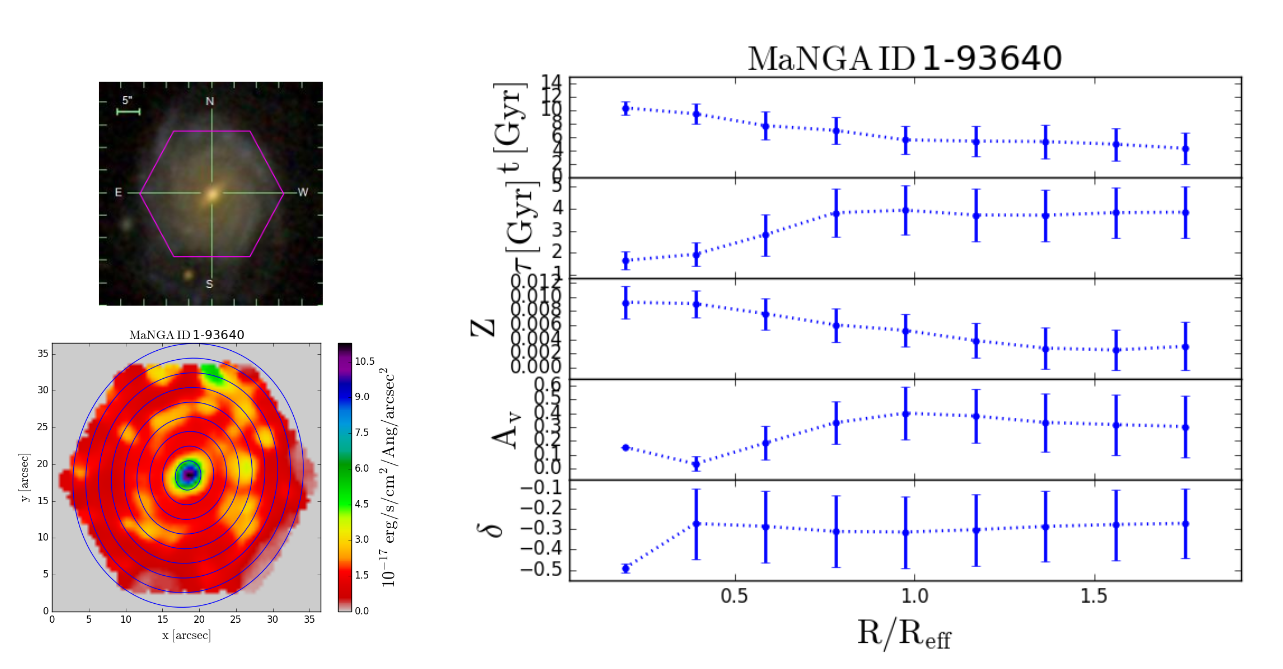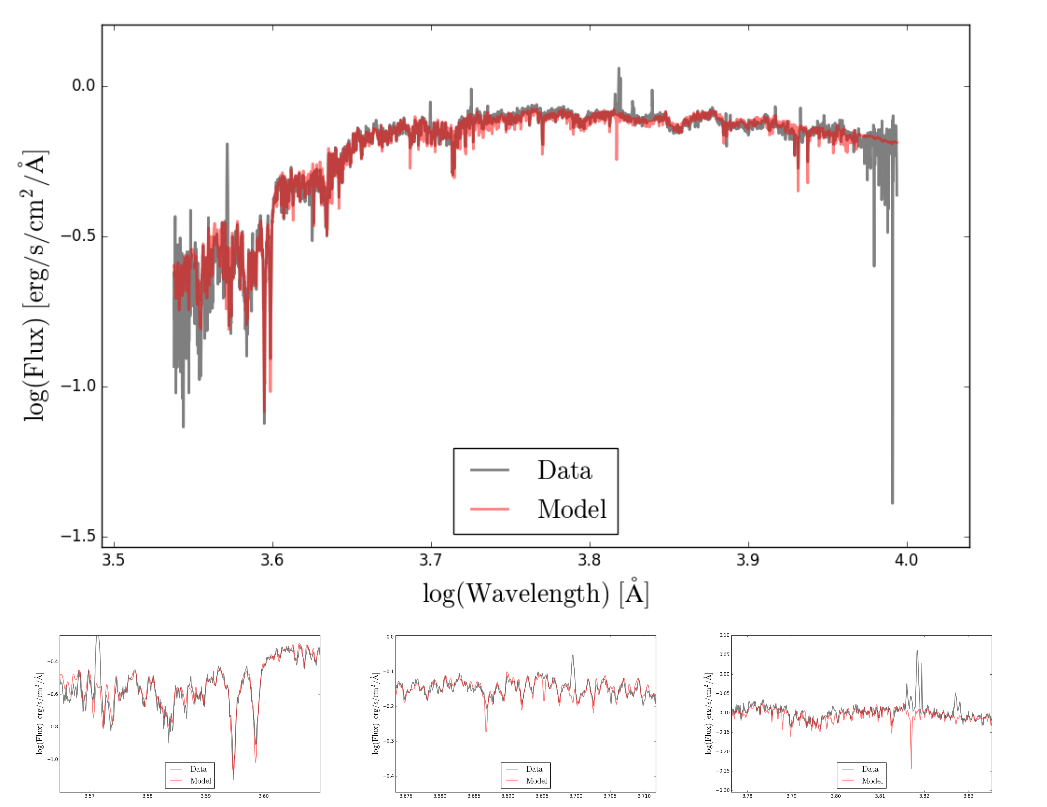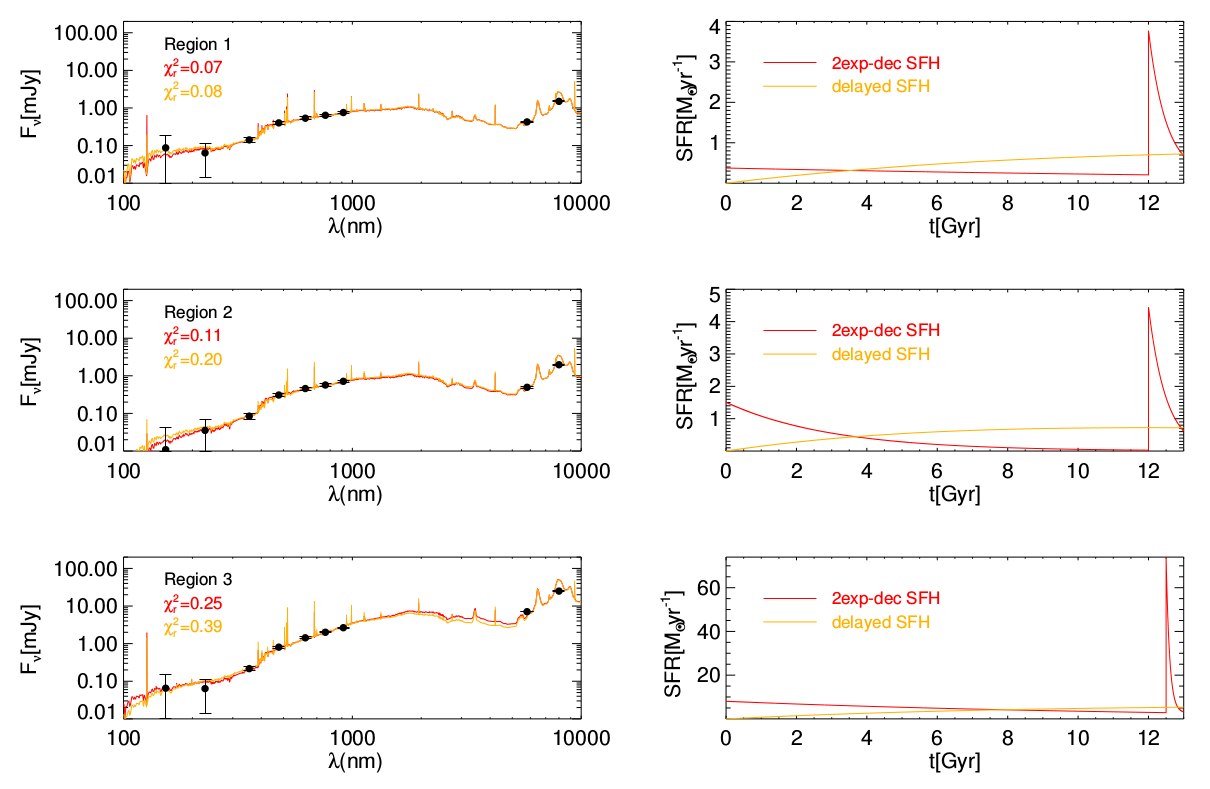China-Chile Proposal
China-Chile Joint Research Fund 2016
Project presentation
- Title: :Star Formation History of Galaxies in Different Environments from MaNGA Spectra
- Abstract (<1000 words):
Star formation is one of the fundamental process governing the formation and evolution of galaxies. The star formation history (SFH) of galaxies allow us to investigate when galaxies formed their stars and assembled their mass. We can constrain the SFH with high level of precision from galaxies with resolved stellar populations, since we are able to discriminate between stars of different ages from the spectrum they emit.
MaNGA (Mapping Nearby Galaxies at APO, Bundy et al. 2016) will provide resolved spectroscopy for nearly 10000 galaxies in the local Universe. MaNGA’s key goals are to understand the “life cycle” of present day galaxies from imprinted clues of their birth and assembly through their ongoing growth via star formation and merging, to their death from quenching at late times.
In this research program we aim to use MaNGA data to constrain the SFH of nearby galaxies and to investigate how they formed and evolve. However, the relative importance of secular evolution (nature) over nurture is not yet clear, and separating the effects of interaction–driven evolution in the observed galaxy properties is not trivial.
Our team count with experts on the field of galaxy formation and evolution, galaxy environment, galaxy spectral modelling, and galaxy chemical evolution models, with experience on working together. In this proposal we ask for a 2-year research program that will advance our understanding of the effects of the environment on galaxy formation and evolution by combining theoretical modelling with MaNGA spectra and state-of-art multi-wavelength observations.
- Area of Research: Galaxies
- Names of project PI and Co-Is and their institutions:
- Médéric Boquien(1) (PI), Shiyin Shen(2) (PI), Maria Argudo-Fernández(1) (Co-I),
- Fangting Yuan(2) (Co-I), Jun Yin(2) (Co-I), Ruixiang Chang(2) (Co-I), Lei Hao(2) (Co-I)
- - University of Antofagasta, Chile
- - Shanghai Astronomical Observatory, Chinese Academy of Sciences, China
Scientific Justification
(less than 8 single-spaced pages, including text, graphics, tables and references).
Galaxy evolution in the era of the SDSS–IV and MaNGA surveys
The appearance of galaxies ultimately depends on the properties of their stellar populations: age, mass, chemical composition, etc. As stars form, evolve and die they produce dust and inject vast amounts of metals in the interstellar medium, which have a direct impact on the formation of new stars, shielding and cooling molecular clouds. In case of intense feedback from young, massive stars, star formation can even be quenched altogether. In other words, star formation is the fundamental process governing the formation and evolution of galaxies.
The Sloan Digital Sky Survey (SDSS) has provided us with spectra for a vast number of low redshift galaxies, yielding for each of them information about their star formation, metallicity, and kinematics. However, this information is limited to a single spatial position at the galaxy’s center. This means that this treasure trove of data unfortunately gives us only very limited information on the structure of gradients in galaxies, which would reveal how galaxies have grown over cosmic times. Integral field unit (IFU) observations enable a leap forward: they provide us with an added dimension to the information available for each galaxy. Clues to the nature of the physical processes that drive star formation in galaxies are encoded in the map.
With the advent of the spatially resolved spectroscopy, from integral field spectroscopy (IFS) data and the multi–band images with good spatial coverage from the ultraviolet with GALEX to the infrared with WISE, new observational results are available to explore galaxy assembly models (Pérez et al., 2013; Sánchez-Blázquez et al., 2014; Pan et al., 2015). To elucidate how galaxies grow with time, one needs to recover the SFH, both in space and time, for individual galaxies. In practice, the SFH of a galaxy is determined by finding the most plausible combination of evolved single stellar populations (SSP) that matches its observed spectrum or SED, the so–called “fossil record method”.
MaNGA (Mapping Nearby Galaxies at Apache Point Observatory, Bundy et al. 2016) is an IFS survey designed to investigate the internal kinematic structure and composition of gas and stars in an unprecedented sample of 10,000 nearby galaxies. The survey is one of three core programs in the fourth–generation Sloan Digital Sky Survey (SDSS–IV) that began on 2014 July 1. In previous SDSS programs the observing mode was from a single fiber spectrum. To overcome this limitation and provide spatially resolved spatial maps, MaNGA has adopted a new strategy by bundling fibers together (see Figure 1).
MaNGA’s key goals are to understand the “life cycle” of present day galaxies from imprinted clues of their birth and assembly through their ongoing growth via star formation and merging, to their death from quenching at late times.
The MaNGA legacy dataset will address urgent questions in our understanding of galaxy formation, including: 1. the nature of present–day galaxy growth via merging and gas accretion, 2. the processes responsible for terminating star formation in galaxies, and 3. the broad formation history of galaxy subcomponents, including the disk, bulge, and dark matter halo.
This research program aims at gaining a unique insight into how nearby galaxies formed and evolve by comparing their observed properties with results from state–of–the–art chemical evolution models. Using MaNGA IFUs, we will measure their SFH with unprecedented precision and accuracy combining IFS data from MaNGA with multi–wavelength SED modeling from the ultraviolet to the infrared. We therefore will provide new constraints on the assembly of galaxies across cosmic times.
Coming up next, we briefly present in more detail the building blocks upon which we will carry out this China-Chile collaboration in astronomical research in Sect. 2. We lay out the research plan for this proposal in Sect. 3.
Figure 1: SDSS three-colour images and MaNGA IFU design for a sample of spiral face-on galaxies.
The involvement on MaNGA projects
Evolution of Spiral Isolated Galaxies with MaNGA
(PI: M. Argudo-Fernández)
From models, it is predicted that disks grow from inner to outer parts of galaxies, the called inside–out model of galaxy formation. This means that first stars form in the center and later in the outer regions. As a consequence, we expect to observe gradients in stellar age and metallicity as a function of galaxy radii. It is very difficult to observe this effect since high spatial and spectral resolution are required. Until recently it was nearly impossible to put precise constraints on the local SFH of distant galaxies. The new IFS data along with multi–wavelength observations provide us with sufficient resolution to study the resolved SFH
along galaxy radii. But separating the effect of the environment on the observed galaxy properties it is also a necessary and challenging question to address. Isolated galaxies and the power of MaNGA data are the key ingredients to reach this goal.
How exactly do galaxies build their disk when they grow in isolation, unaffected by external influences? We aim of characterizing the star formation history of isolated galaxies, under the assumption of the inside-out scenario, and to compare with chemical evolution models using MaNGA IFU data. The sample of isolated galaxies used in this study is selected from the SDSS-based catalogue of Isolated Galaxies (SIG, Argudo-Fernández et al., 2015). Preliminary results are shown in Figure 2. We already studied the effects of the environment in active galactic nuclei (AGN) for these galaxies using one-fiber spectra (Argudo-Fernández et al., 2016). We can also use IFU data to test if AGN is real or it is more related to star formation. We expect, for the very first time, to find some clues on how spiral galaxies form and evolve combining results from the spectral fitting techniques, with the predictions from CEMs, that are being developed in the Shanghai Astronomical Observatory by experts in the field.
Figure 2: Results for a SIG galaxy with MaNGA data (MaNGA ID galaxy 1-93640). The left upper panel shows the SDSS three-colour image of the galaxy with its IFU plate design. The lower left panel shows the Hα map of the galaxy and the set of radial bins in which we divide the galaxy to study the stellar populations. The left panel shows the results of the radial gradients of the SFH parameters, stellar metallicity, and dust parameters in each radial bin as a function of the effective radius of the galaxy.
Environmental effects on star formation properties in galaxy pairs
(PI: Fangting Yuan)
Merging is a presumably cause to transfer blue and star-forming galaxies to red and dead galaxies. Simulation shows that the interaction of two galaxies in a pair can cause the gas inflow and thus starburst in the center region of the galaxies. Many observations have found that there is enhancement of star formation in galaxy pairs. However, the enhancement may depend on the local environment (see e.g. Tonneson et al., 2014). Also, the spatial extent of the enhanced star formation in pairs is still not clear. Although many studies found the SF enhancement is in center region, there are also cases showing that the star formation widely spread to bridge and tidal tail regions. A recent work by Moreno et al., 2015 shows that pair interactions can cause the enhancement of star formation in the center, but at the same time suppress the activity at outskirts.
We select the pair sample from the catalogue of groups constructed by Yang et al. (2007) based on SDSS-DR7 data. The spectroscopic redshifts for the companion galaxies are collected not only from SDSS-DR7, but also SDSS-DR10, NED and LAMOST, in order to minimize the fiber collision effect which causes the missing of the spectrum of one member galaxy in a close pair. Especially, the LAMOST data are obtained through the project dedicated to complement the spectroscopic redshifts of SDSS close pairs with LAMOST spectroscopy (Shen et al. 2016). Two galaxies are selected as a pair if they satisfy the following criteria: 1) Both galaxies have spectroscopic redshifts; 2) The projected separation is less than 50 kpc; 3) The velocity difference is less than 500 km/s. A part of this sample (include ~1000 galaxies) is selected for MaNGA observation, and will obtain the 2D spectra of these pairs in future 4 years.
We focus on exploring how the environment affects the properties in galaxy close pairs. Yang et al. (2007)’s group catalogue already provides us with halo mass of each pairs, which can be used as a parameter to indicate the environment. We also use tidal strength parameters that measure the local galaxy density of each pair (Argudo-Fernández et al., 2015) as another approach to describe the environment. Based on this SDSS pair sample, we can statistically explore the environmental dependence of pairs. On the other hand, MaNGA IFU allows us to study the spatially resolved properties of galaxies, and therefore can further help us clarify in which part the SFR/dust is changed, and whether the spatial variation has some dependence on the environment.
Metallicity evolution in SED modelling for MaNGA spectra
(PI: Shiyin Shen)
To be filled by Shiyin
Médéric’s MaNGA project
(PI: Médéric Boquien)
To be filled by Médéric
Constraining the SFH from MaNGA spectra
Many of the fundamental properties of galaxies are encoded in their spectral energy distribution (SED). These properties include the star formation history (SFH), stellar metallicity and abundance pattern, stellar initial mass function (IMF), total mass in stars, and the physical state and quantity of dust and gas. Some of these properties are easier to measure than others, and each provides important clues regarding the formation and evolution of galaxies. It is precisely these quantities, measured from the SEDs of galaxies, that have provided the foundation for our modern understanding of galaxy formation and evolution.
Based on the experience of this team on working with MaNGA data, on modelling SED spectra and on the creation of CEM, we propose here to create a China-Chile astronomy research project to model SED spectra to accurately constrain the SFH of nearby galaxies with MaNGA IFU observations using CIGALE. CIGALE (Code Investigating GALaxy Emission, Boquien et al., in prep.; Burgarella et al., in preparation) is a state–of–the–art SED modelling code from the far–ultraviolet to the radio domain, including the contributions from stellar populations of all ages, thermal and non–thermal gas emission, dust (both in absorption and emission), and optionally an active nucleus. To estimate the physical properties of the modelled targets, it is based on a Bayesian–like analysis method. Prof. Médéric Boquien is one of the leaders of CIGALE. He has a large experience on spatially resolved multi–wavelength SED modeling, in particular he made an extensive use of CIGALE spectral energy distribution fitting code to model the emission of spiral galaxies (Boquien et al., 2012).
The starting point of any stellar population synthesis (SPS) model is the simple stellar population (SSP), which describes the evolution in time of the SED of a single stellar population (or single age population) at a single metallicity and abundance pattern. An SSP therefore requires three basic inputs: stellar evolution theory in the form of isochrones, stellar spectral libraries, and an IMF, each of which may in principle be a function of metallicity and/or elemental abundance pattern.
The most robust approach to estimating stellar metallicities is to employ spectroscopic features. Optical spectra of galaxies are rich in atomic and molecular absorption features that are readily apparent even at low spectral resolution (R ∼ 1000). For a fixed population age, the strengths of the absorption features will depend not only on the overall metallicity but also on the detailed elemental abundance pattern. In general, this greatly complicates the interpretation of absorption features and spectral indices. However, with the aid of models that allow for a variation in both metallicity and abundance pattern, one can search for combinations of features that are relatively robust against abundance pattern variations. With respect to this, BCO3 models are also available at different metallicity ranges. As previously introduced, for first results I fixed the models to solar metallicity. Next steps in this aspect include an estimation of the metallicity from MaNGA spectra to select the most adequate SPS model in each region of the galaxy. This information will also useful to retrieve physical properties from CIGALE as it uses the BC03 models as in input to model stellar populations.
Figure 3: Result of the best fit model spectra created by CIGALE (red line) for a randomly selected spectra from MaNGA (black line). The lower panels show a zoom in three different wavelength regions.
In conjunction to follow-up multi-wavelength observations, we also plan to build upon the experience of the team of spectral fitting to extend CIGALE, which for now does band (photometric) fitting. This would be highly synergistic since at the moment there is no code that can carry out simultaneously spectral and band modeling from the ultraviolet to the infrared. This new resource will allow us to get a better handle on the continuum attenuation, since the Balmer decrement is only for the ionised gas and the conversion to a continuum attenuation is uncertain, and break more reliably the age–attenuation degeneracy, among other things. Therefore, used in combination with spatially resolved multi-wavelength data to complement MaNGA observations, this will allow us to obtain better estimates on the SFH and other physical properties of nearby galaxies.
This team has already a first attempt to combine spectra and photometry to study the SFH of a galaxy merger observed with MaNGA. Galaxy mergers play an important role in the formation and evolution of galaxies and their dark matter halos. The UV and IR data are used to constrain the star formation rate and dust attenuation for mergers, which are tracers of the evolutionary stage of the systems. However, spatially resolved studies of galaxy mergers are restricted to very close galaxies, especially due to the lack spatial resolution in IR data. In Yuan et al. (in preparation), we show how the use of UV-to-IR broadband SED (see Figure 4), in combination with MaNGA IFS (see Figure 5), provide unique opportunity to study the star formation histories and dust attenuation at the tail and core parts of the merging galaxy Mrk 848.
Figure 4: Fitting results by CIGALE for the regions 1, 2, and 3 of the merger Mrk 848 from GALEX, ugriz SDSS bands, and IRAC data. Black dots are observed band fluxes. Red lines indicate the results of SED fitting assuming a two exponentially decreasing SFH. Yellow lines indicate the results of SED fitting assuming a delayed SFH.
Figure 5: Interacting pair Mrk 848. The left panel shows the SDSS three-colour image of the object. Yellow circles correspond to the regions completely covered by the MaNGA IFU, meanwhile regions with red circles correspond to regions not covered or partially covered. The middle panel shows the MaNGA Hα map of the galaxy merger. Flux units are per spatial pixel. The left panel shows the estimated SFH for each selected region in colour-code according to the legend.
Implementation Plan of research
Including project duration (one or two years)
Ideas:
- 2 years
- Annual workshop (1 year Chile, 1 year China) with participation of other MaNGA team expert members
- Summer students
- Follow-up observations
Itemized budget
CV of the PI(s), a list of currently supported research programs, and a list of publications relevant to the proposal
Supported research programs:
- "Evolution of Spiral Isolated Galaxies with MaNGA" FONDECYT postdoctoral N° 3160304
-
- add more projects*
List of publications
- Please add publications that you consider*
We present here a list of publications where this team has been working together in the context of this proposal or the work of individual team members in related projects.
1.- ‘’Catalogues of isolated galaxies, isolated pairs, and isolated triplets in the local Universe’’ , M. Argudo-Fernández; S. Verley; G. Bergond; S. Duarte Puertas; E. Ramos Carmona; J. Sabater; M. Fernández Lorenzo; D. Espada; J. Sulentic; J. E. Ruiz; S. Leon, A&A, 578A, 110A (2015)
2.- ‘’Isolated Galaxies versus Interacting Pairs with MaNGA’’ , M. Argudo- Fernández, F. Yuan, S. Shen, J. Yin, R. Chang, S. Feng, Galaxies, 3, 156F (2015). 3.- ‘’A sample of galaxy pairs identi ed from the LAMOST spectral survey and the Sloan Digital Sky Survey’’ , Shiyin Shen, M. Argudo-Fernandez, Li Chen , Xiaoyan Chen, Shuai Feng, Jinliang Hou, Peng Jiang, Yipeng Jing, Xu Kong, Ali Luo, Zhijian Luo, Zhengyi Shao, Tinggui Wang, Wenting Wang, Hong Wu, Xuebing Wu, Haifeng Yang, Ming Yang, Fangting Yuan, Hailong Yuan, Haotong Zhang, and Jiannan Zhang, RAA, 16c, 7S (2016).
4.- ‘’An Isolated Compact Galaxy Triplet’’, Shuai Feng, Zheng-Yi Shao, Shi-Yin Shen, Maria Argudo-Fernandez, Hong Wu, Man-I Lam, Ming Yang, and Fang-Ting Yuan, RAA, 16e, 3F (2016).
5.- ‘’Effects of local and large-scale environments on nuclear activity and star formation’’ , M. Argudo-Fernández; S. Shen; J. Sabater; S. Duarte Puertas; S. Verley, A&A, 592A, 30A (2016).
6.- ‘’SDSS-IV MaNGA: Properties of galaxies with kinematically decoupled stellar and gaseous components’’, Jin, Yifei; Chen, Yanmei; Shi, Yong; Tremonti, C. A.; Bershady, M. A.; Merrifield, M.; Emsellem, E.; Fu, Hai; Wake, D.; Bundy, K.; Lin, Lihwai; Argudo-Fernández, M.; Huang, Song; Stark, D. V.; Storchi-Bergmann, T.; Bizyaev, D.; Brownstein, J.; Chisholm, J.; Guo, Qi; Hao, Lei; Hu, Jian; Li, Cheng; Li, Ran; Masters, K. L.; Malanushenko, E.; Pan, Kaike; Riffel, R. A.; Roman-Lopes, A.; Simmons, A.; Thomas, D.; Wang, Lan; Westfall, K.; Yan, Renbin, MNRAS, accepted (2016).
7.- ‘’The growth of the central region by acquisition of counter-rotating gas innstar-forming galaxies,’’ YanMei Chen; Yong Shi; C. A. Tremonti; M. Bershady; M. Merrifield; E. Emsellem; YiFei Jin; Song Huang; Hai Fu; D. A. Wake; K. Bundy; D. Stark; Lihwai Lin; YenTing Lin; M. Argudo-Fernandez; T. Storchi-Bergmann; D. Bizyaev; J. Brownstein; M. Bureau; J. Chisholm; Ni. Drory; Qi Guo; Lei Hao; Jian Hu; Cheng Li; Ran Li; A. Roman Lopes; Kai-Ke Pan; R. A. Riffel; D. Thomas; Lan Wang; K. Westfall; RenBin Yan, submitted to Nature.
8.- ‘’Stellar Population Gradients as a Function of Galaxy Mass and Environment’’, D, Goddard; D. Thomas, C. Maraston, K. Westfall, J. Etherington, R. Riffel, N. D. Mallmann, Z. Zheng, M. Argudo-Fernandez, M. Bershady, K. Bundy, N. Drory, D. Law, R. Yan, D. Wake, A. M. Weijmans, D. Bizyaev, J. Brownstein, R. R. Lane, R. Maiolino, K. Masters, M. Merrifield, C. Nitschelm, K. Pan, A. Roman-Lopes, T. Storchi-Bergmann, submitted to MNRAS.
9.-‘’Spatially Resolved Star Formation Histories in Galaxies as a Function of Galaxy Mass and Type’’, D, Goddard; D. Thomas, C. Maraston, K. Westfall, J. Etherington, R. Riffel, N. D. Mallmann, Z. Zheng, M. Argudo-Fernandez, M. Bershady, K. Bundy, N. Drory, D. Law, R. Yan, D. Wake, A. M. Weijmans, D. Bizyaev, J. Brownstein, R. R. Lane, R. Maiolino, K. Masters, M. Merrifield, C. Nitschelm, K. Pan, A. Roman-Lopes, T. Storchi-Bergmann, submitted to MNRAS.
10.- ‘’Star Formation History of the Galaxy Merger Mrk848 with SDSS-IV MaNGA’’, F. Yuan; S. Shen; L. Hao; Maria Argudo-Fernandez, in preparation.
11.- ‘’Star formation histories of isolated galaxies with MaNGA’’, Maria Argudo-Fernandez; M. Boquien; S. Shen; F. Yuan, J. Yin, R. Chang, K. Bundy, C. Liu, in preparation.




